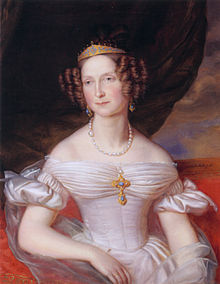Anna Pavlovna of Russia
| Anna Pavlovna of Russia | |
|---|---|

Portrait by Jan Baptist van der Hulst, 1837
|
|
|
Queen consort of the Netherlands Grand Duchess consort of Luxembourg Duchess consort of Limburg |
|
| Tenure | 7 October 1840 – 7 March 1849 |
| Born |
18 January 1795 Saint Petersburg, Russia |
| Died | 1 March 1865 (aged 70) The Hague, Netherlands |
| Burial | Nieuwe Kerk, Delft |
| Spouse | William II of the Netherlands |
| Issue |
William III of the Netherlands Prince Alexander Prince Henry Prince Ernest Casimir Sophie, Grand Duchess of Saxe-Weimar-Eisenach |
| House | Holstein-Gottorp-Romanov |
| Father | Paul I of Russia |
| Mother | Sophie Dorothea of Württemberg |
| Religion | Russian Orthodox |
Anna Pavlovna of Russia (Russian: Анна Павловна; St. Petersburg, 18 January 1795 — The Hague, 1 March 1865) was a queen consort of the Netherlands. In the Netherlands, due to nineteenth century Dutch transliteration conventions, she is better known as Anna Paulowna.
She was born in 1795 at Gatchina Palace, the eighth child and sixth daughter of Paul I of Russia and Empress Maria Feodorovna (born Sophie Dorothea of Württemberg), and thus was Her Imperial Highness Grand Duchess Anna Pavlovna of Russia. Anna was raised by her mother at the summer residence of the Romanovs, Tsarskoye Selo. She spent her childhood there with her two younger brothers, Nicholas (1796-1855) and Michael (1798-1849). Anna received a broad education, including foreign languages and maths. She was good at handicrafts and painting.
In 1809, after failing to secure her elder sister Ekaterina, Emperor Napoleon I of France asked for Anna’s hand in marriage. Her mother managed to delay her reply long enough for Napoleon to lose interest and marry Archduchess Marie Louise, the eighteen-year-old daughter of the Austrian emperor.
On 21 February 1816 at the Chapel of the Winter Palace in St Petersburg, she married the Prince of Orange, who would later become King William II of the Netherlands. The marriage had been suggested by her brother the Tsar Alexander I in 1815, as a symbol of the alliance created after the Congress of Vienna. As it had been decided that no member of the Romanov family should be forced to marry against their will, William was invited to Russia before the wedding so that Anna could get to know him and consent to marry him, which she did. At the time of their marriage, it was agreed that Prince Willem’s children should be raised as Protestants, although Anna herself remained Russian Orthodox.Alexander Pushkin celebrated the marriage in a special poem entitled To the Prince of Orange. The couple remained in Russia for one year.
...
Wikipedia
